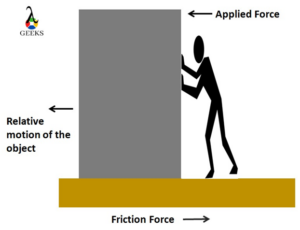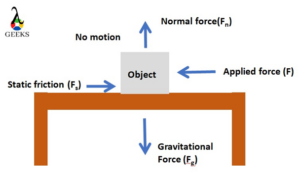Friction is retarding force applied to an object to restrict the movement of the object which is in contact with another object.
The friction is classified into two types based on their properties, behavior, and state of the matter as “dry friction and fluid friction”. This article is focused on the study of what is dry friction and types of dry friction.
What is dry friction?
To answer the above question, consider an example of pushing an object which moves in contact with another. When an object is pushed over a surface, the motion of the object and the applied force act in the same direction, but the object never moves so quickly it takes too much force to move. The motion is retarded by force is called friction.
The dry friction is defined as “The force of resistances offered between the two solid surfaces in contact with each other retards the relative tangential motion in the opposite direction.”

Interesting Facts
- Usually, dry friction is used as a synonym for “Friction”.
- The dry friction evolve between the solid surfaces is corresponding to the normal force acting on the surfaces.
- The magnitude of the area enclosed between the two surfaces in contact does not involve dry friction.
- The nature of the material which is to be experienced the frictional force may affect the dry friction.
- Dry friction depends on the nature of the contact materials. It is measured by a unitless quantity called “Coefficient of friction.”
- Roughness of the surfaces does not affect the dry friction in case of some exceptional materials.
- The area between the two contact surfaces is the individual quantity, which does not affect the dry friction.
- The velocity at which the object is moving does not affect the dry friction only when the velocity is low.
- The angle between total resultant friction acting between the two surfaces and the normal force exerted on the surfaces is called the angle of friction.
- The applied force and the friction force are equal as long as the object is at rest.
Types Of Dry Friction
Dry friction is applicable for non-lubricant materials. It is classified mainly into two types based on their properties. They are;
These two types of dry friction exhibit distinct behavior, characteristics that we are going to study in this section.
Static friction
A tendency of an object to keep it at rest is called static friction.
When you try to push a table or a shopping cart, you exert more force on the table for the first push. Do you ever think why the first push is always so harder?

Yes, because static friction is acting on the cart or table. It hinders the motion of the table or card which is at rest when you try to push for the first time. Meanwhile the table tries to overcome this friction after the first push. So you feel little ease to push after the first push.
So the static friction is defined as “the friction that exerted on the stationary body without triggering the motion of another body which is in contact.”

The expression for the static friction is given using the inequality equation.
Fs ≤ µs N
Where Fs is the force of static friction
µs is the coefficient of static friction
N is the normal force acting between the two surfaces.
- The area occupied between the two contact surfaces influences the static friction.
- The increase in the normal force acting on the surfaces makes the maximum external force applied on the stationary surfaces also increases. This means that normal force and applied force are proportional.
Limiting static friction
The maximum static friction exerted on the body, which is about to move over the surface of another body, is called the limiting static friction.
When we exert more force on the stationary body, it overcome from the limiting friction and begins to move. As the body is no more in the stationary state, this leads to another type of friction called Kinetic friction.
Kinetic friction
The kinetic friction is also called “dynamic friction.” It is the force that acts between moving body.
When you roll a ball, you have experienced this friction. When the ball is rolled on the surface, its motion is retarded by some force exerted on the ball, and motion is held back. This is due to the kinetic friction.

So, kinetic friction can be defined as “the friction force acting between the surfaces which are in relative motion with each other, experiences the resistance in the opposite direction.”
The kinetic friction acting on the object is given by the formula
Fk = µkFN
Where; µk is the coefficient of kinetic friction.
And FN is the normal force.
When the surface is in the horizontal direction, there is no vertical component of force. Then the normal force is FN = mg.
Fk =mgµk
The kinetic friction is subdivided into two types

Sliding friction
It is the friction produced when a body slides over the other body so that the relative motion of the body is resisted.
It is given by the formula,
Fs = µs FN
Where; µs is the coefficient of sliding friction.
FN is the normal force acting on the object.
It is observed that the formula for sliding and static friction is almost the same but value of sliding friction is always less than the static friction.
Rolling friction
It is friction when the body is rolled on the surface of another body. The relative motion of the body is retarded.
It is given by the formula
Fr = Crr FN
Where; Crr is the coefficient of rolling friction
FN is the normal force acting on the body.
Need to know facts
- The rubbing of two objects is kinetic friction. When the two objects are rubbed, heat is produced. This is because kinetic friction is transform as thermal energy.
- Lubrication prevents kinetic friction, which is involved in the wear and tear of the machine parts.
Facts of kinetic friction
- The kinetic friction and the normal reaction between the surfaces are proportional to each other.
- Kinetic friction depends on the roughness of the contact surfaces.
- The shape, size, and area of the contact surfaces do not influence the kinetic friction.
- The velocity at which the surfaces are moving in contact does not affect the kinetic friction. The velocity of the surface and object are almost equal, there is no much variation between them.
The variation of dry friction with the applied force is represented below the graph, which gives the value of static and kinetic friction.

Coefficient of friction
The coefficient of friction gives the relation between the two objects in contact and the reactions that acting between those objects.
It is defined as “the ratio of the two materials moving one over the other and the force holding to be in contact with each other.”
The Greek alphabet “µ” is the symbol to represent the coefficient of friction. Different materials exhibit different friction coefficient. It ranges from zero to greater than 1. Usually coefficient of static friction is greater compared to the kinetic friction.
Read more about Element 115, Moscovium.
Also Read:
- Ozone generator ozonator
- How to calculate solubility
- Good conductors examples
- Is impulse conserved
- Equatorial vs altazimuth mounts
- S polarized
- Uses of pulley
- Loudness and amplitude
- Micrometer calibration
- Properties of reflection
I am Keerthi K Murthy, I have completed post graduation in Physics, with the specialization in the field of solid state physics. I have always consider physics as a fundamental subject which is connected to our daily life. Being a science student I enjoy exploring new things in physics. As a writer my goal is to reach the readers with the simplified manner through my articles.